Strategic Planning Issues of Transportation Sector in Melbourne
VerifiedAdded on 2023/04/04
|15
|3539
|53
AI Summary
This essay discusses the strategic planning issues of transportation sectors in Melbourne and provides solutions and recommendations to address these issues.
Contribute Materials
Your contribution can guide someone’s learning journey. Share your
documents today.
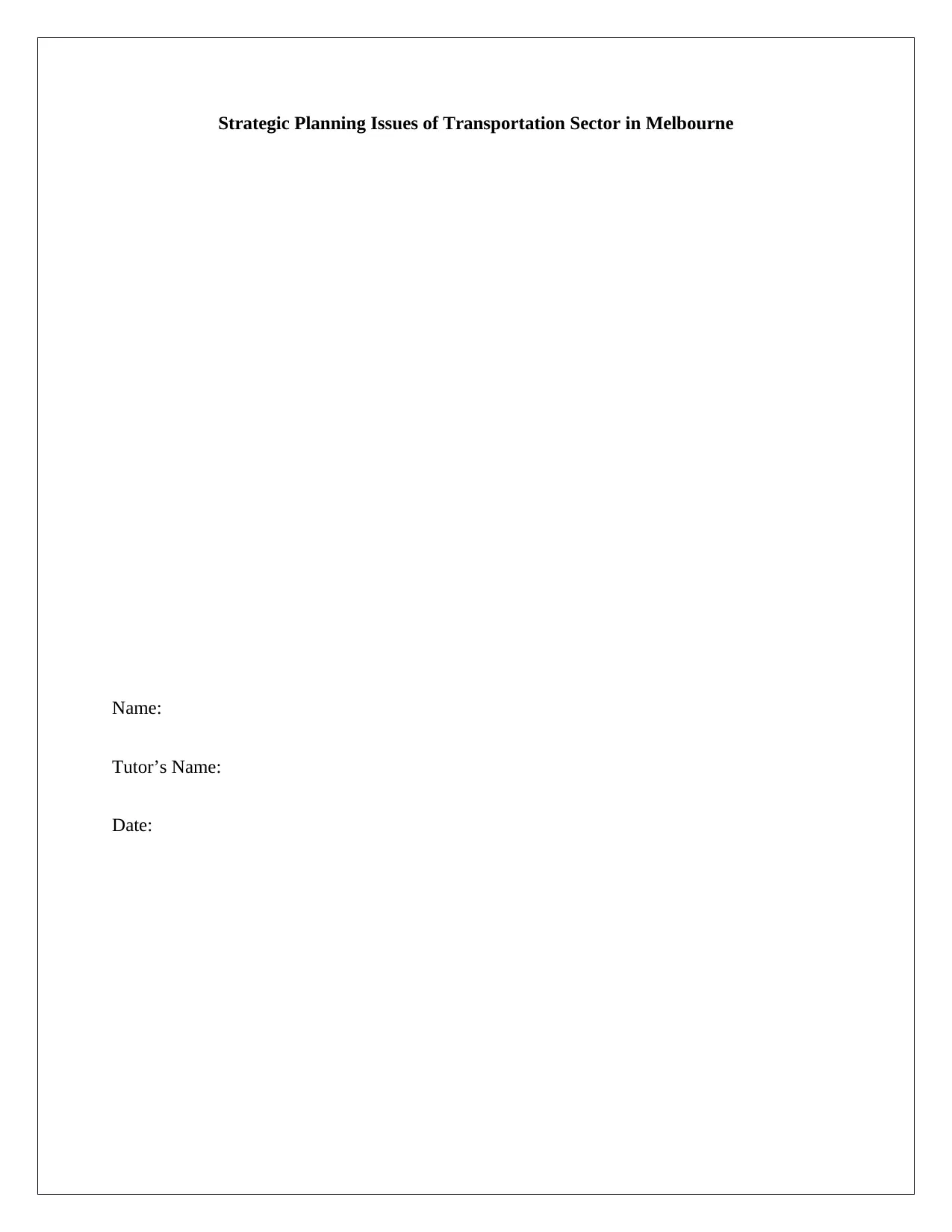
Strategic Planning Issues of Transportation Sector in Melbourne
Name:
Tutor’s Name:
Date:
Name:
Tutor’s Name:
Date:
Secure Best Marks with AI Grader
Need help grading? Try our AI Grader for instant feedback on your assignments.

Table of Contents
Introduction......................................................................................................................................3
Strategic Planning Issues of Transportation Sector.........................................................................4
Strategic Planning Decision on the Issues.......................................................................................5
Solution to Address the Strategic Planning Issues..........................................................................6
Challenges Encountered While Addressing the Strategic Planning Issues.....................................8
Recommendation to Address the Strategic Planning Issues............................................................9
Urban Transport System strategic plan of Melbourne...................................................................10
Conclusion.....................................................................................................................................12
References......................................................................................................................................14
Page | 2
Introduction......................................................................................................................................3
Strategic Planning Issues of Transportation Sector.........................................................................4
Strategic Planning Decision on the Issues.......................................................................................5
Solution to Address the Strategic Planning Issues..........................................................................6
Challenges Encountered While Addressing the Strategic Planning Issues.....................................8
Recommendation to Address the Strategic Planning Issues............................................................9
Urban Transport System strategic plan of Melbourne...................................................................10
Conclusion.....................................................................................................................................12
References......................................................................................................................................14
Page | 2
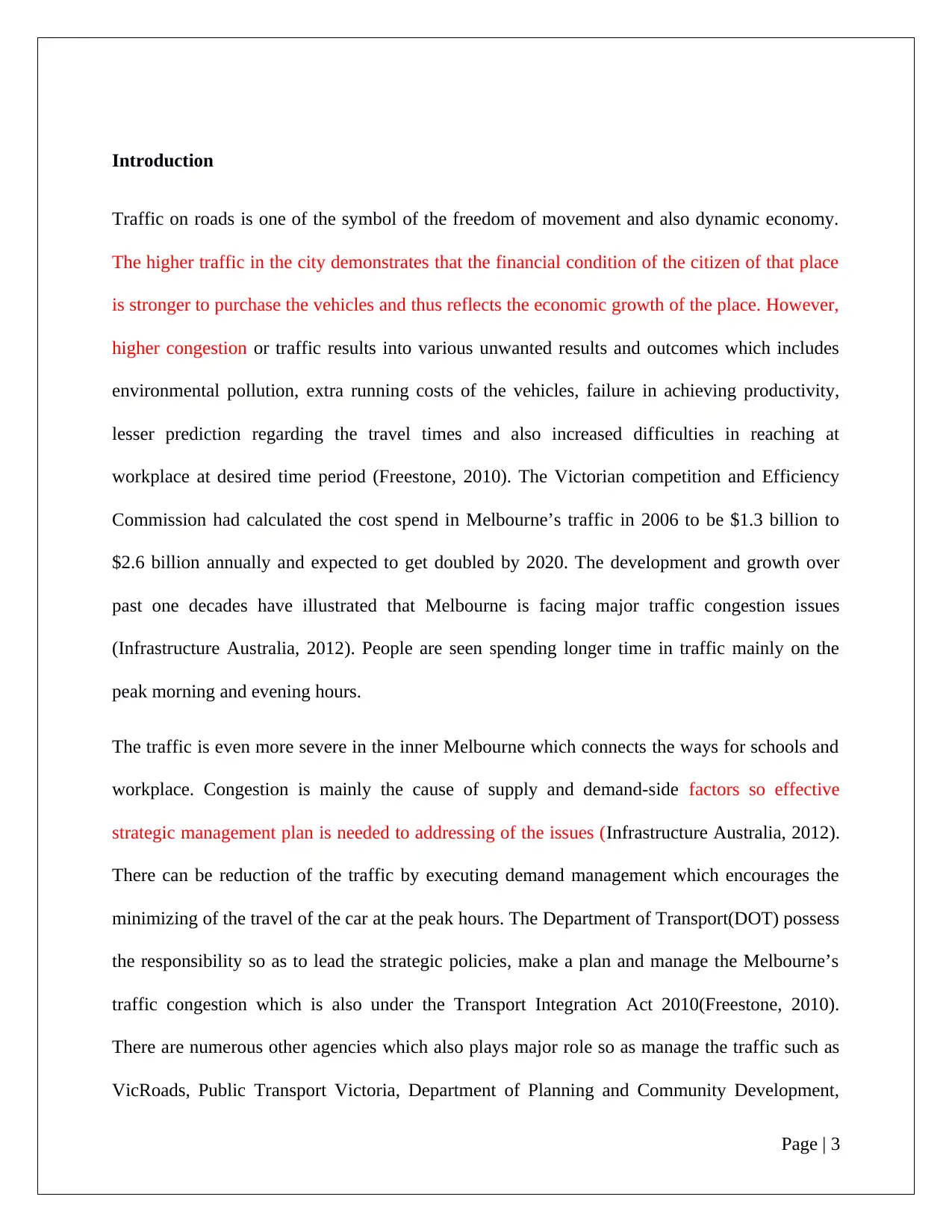
Introduction
Traffic on roads is one of the symbol of the freedom of movement and also dynamic economy.
The higher traffic in the city demonstrates that the financial condition of the citizen of that place
is stronger to purchase the vehicles and thus reflects the economic growth of the place. However,
higher congestion or traffic results into various unwanted results and outcomes which includes
environmental pollution, extra running costs of the vehicles, failure in achieving productivity,
lesser prediction regarding the travel times and also increased difficulties in reaching at
workplace at desired time period (Freestone, 2010). The Victorian competition and Efficiency
Commission had calculated the cost spend in Melbourne’s traffic in 2006 to be $1.3 billion to
$2.6 billion annually and expected to get doubled by 2020. The development and growth over
past one decades have illustrated that Melbourne is facing major traffic congestion issues
(Infrastructure Australia, 2012). People are seen spending longer time in traffic mainly on the
peak morning and evening hours.
The traffic is even more severe in the inner Melbourne which connects the ways for schools and
workplace. Congestion is mainly the cause of supply and demand-side factors so effective
strategic management plan is needed to addressing of the issues (Infrastructure Australia, 2012).
There can be reduction of the traffic by executing demand management which encourages the
minimizing of the travel of the car at the peak hours. The Department of Transport(DOT) possess
the responsibility so as to lead the strategic policies, make a plan and manage the Melbourne’s
traffic congestion which is also under the Transport Integration Act 2010(Freestone, 2010).
There are numerous other agencies which also plays major role so as manage the traffic such as
VicRoads, Public Transport Victoria, Department of Planning and Community Development,
Page | 3
Traffic on roads is one of the symbol of the freedom of movement and also dynamic economy.
The higher traffic in the city demonstrates that the financial condition of the citizen of that place
is stronger to purchase the vehicles and thus reflects the economic growth of the place. However,
higher congestion or traffic results into various unwanted results and outcomes which includes
environmental pollution, extra running costs of the vehicles, failure in achieving productivity,
lesser prediction regarding the travel times and also increased difficulties in reaching at
workplace at desired time period (Freestone, 2010). The Victorian competition and Efficiency
Commission had calculated the cost spend in Melbourne’s traffic in 2006 to be $1.3 billion to
$2.6 billion annually and expected to get doubled by 2020. The development and growth over
past one decades have illustrated that Melbourne is facing major traffic congestion issues
(Infrastructure Australia, 2012). People are seen spending longer time in traffic mainly on the
peak morning and evening hours.
The traffic is even more severe in the inner Melbourne which connects the ways for schools and
workplace. Congestion is mainly the cause of supply and demand-side factors so effective
strategic management plan is needed to addressing of the issues (Infrastructure Australia, 2012).
There can be reduction of the traffic by executing demand management which encourages the
minimizing of the travel of the car at the peak hours. The Department of Transport(DOT) possess
the responsibility so as to lead the strategic policies, make a plan and manage the Melbourne’s
traffic congestion which is also under the Transport Integration Act 2010(Freestone, 2010).
There are numerous other agencies which also plays major role so as manage the traffic such as
VicRoads, Public Transport Victoria, Department of Planning and Community Development,
Page | 3
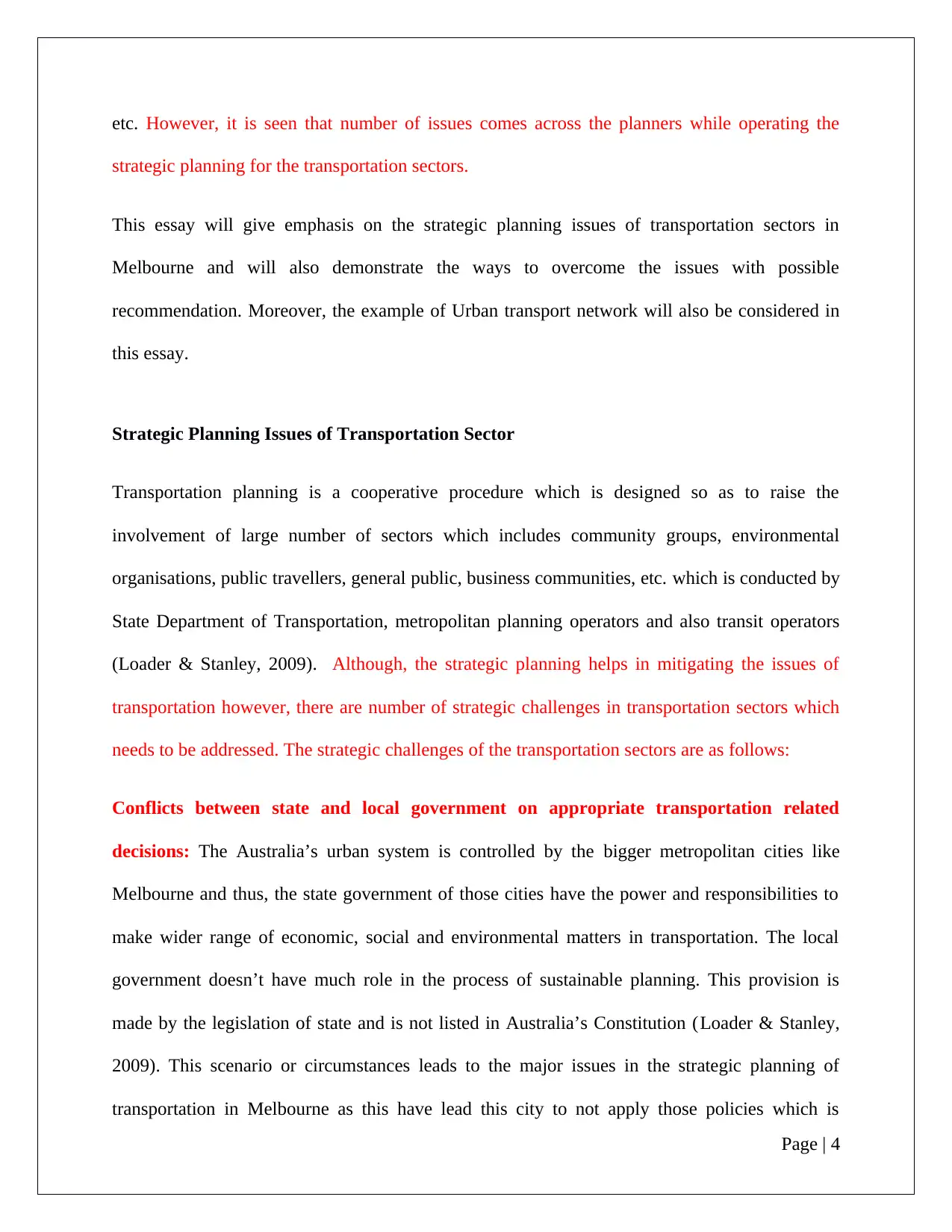
etc. However, it is seen that number of issues comes across the planners while operating the
strategic planning for the transportation sectors.
This essay will give emphasis on the strategic planning issues of transportation sectors in
Melbourne and will also demonstrate the ways to overcome the issues with possible
recommendation. Moreover, the example of Urban transport network will also be considered in
this essay.
Strategic Planning Issues of Transportation Sector
Transportation planning is a cooperative procedure which is designed so as to raise the
involvement of large number of sectors which includes community groups, environmental
organisations, public travellers, general public, business communities, etc. which is conducted by
State Department of Transportation, metropolitan planning operators and also transit operators
(Loader & Stanley, 2009). Although, the strategic planning helps in mitigating the issues of
transportation however, there are number of strategic challenges in transportation sectors which
needs to be addressed. The strategic challenges of the transportation sectors are as follows:
Conflicts between state and local government on appropriate transportation related
decisions: The Australia’s urban system is controlled by the bigger metropolitan cities like
Melbourne and thus, the state government of those cities have the power and responsibilities to
make wider range of economic, social and environmental matters in transportation. The local
government doesn’t have much role in the process of sustainable planning. This provision is
made by the legislation of state and is not listed in Australia’s Constitution (Loader & Stanley,
2009). This scenario or circumstances leads to the major issues in the strategic planning of
transportation in Melbourne as this have lead this city to not apply those policies which is
Page | 4
strategic planning for the transportation sectors.
This essay will give emphasis on the strategic planning issues of transportation sectors in
Melbourne and will also demonstrate the ways to overcome the issues with possible
recommendation. Moreover, the example of Urban transport network will also be considered in
this essay.
Strategic Planning Issues of Transportation Sector
Transportation planning is a cooperative procedure which is designed so as to raise the
involvement of large number of sectors which includes community groups, environmental
organisations, public travellers, general public, business communities, etc. which is conducted by
State Department of Transportation, metropolitan planning operators and also transit operators
(Loader & Stanley, 2009). Although, the strategic planning helps in mitigating the issues of
transportation however, there are number of strategic challenges in transportation sectors which
needs to be addressed. The strategic challenges of the transportation sectors are as follows:
Conflicts between state and local government on appropriate transportation related
decisions: The Australia’s urban system is controlled by the bigger metropolitan cities like
Melbourne and thus, the state government of those cities have the power and responsibilities to
make wider range of economic, social and environmental matters in transportation. The local
government doesn’t have much role in the process of sustainable planning. This provision is
made by the legislation of state and is not listed in Australia’s Constitution (Loader & Stanley,
2009). This scenario or circumstances leads to the major issues in the strategic planning of
transportation in Melbourne as this have lead this city to not apply those policies which is
Page | 4
Secure Best Marks with AI Grader
Need help grading? Try our AI Grader for instant feedback on your assignments.
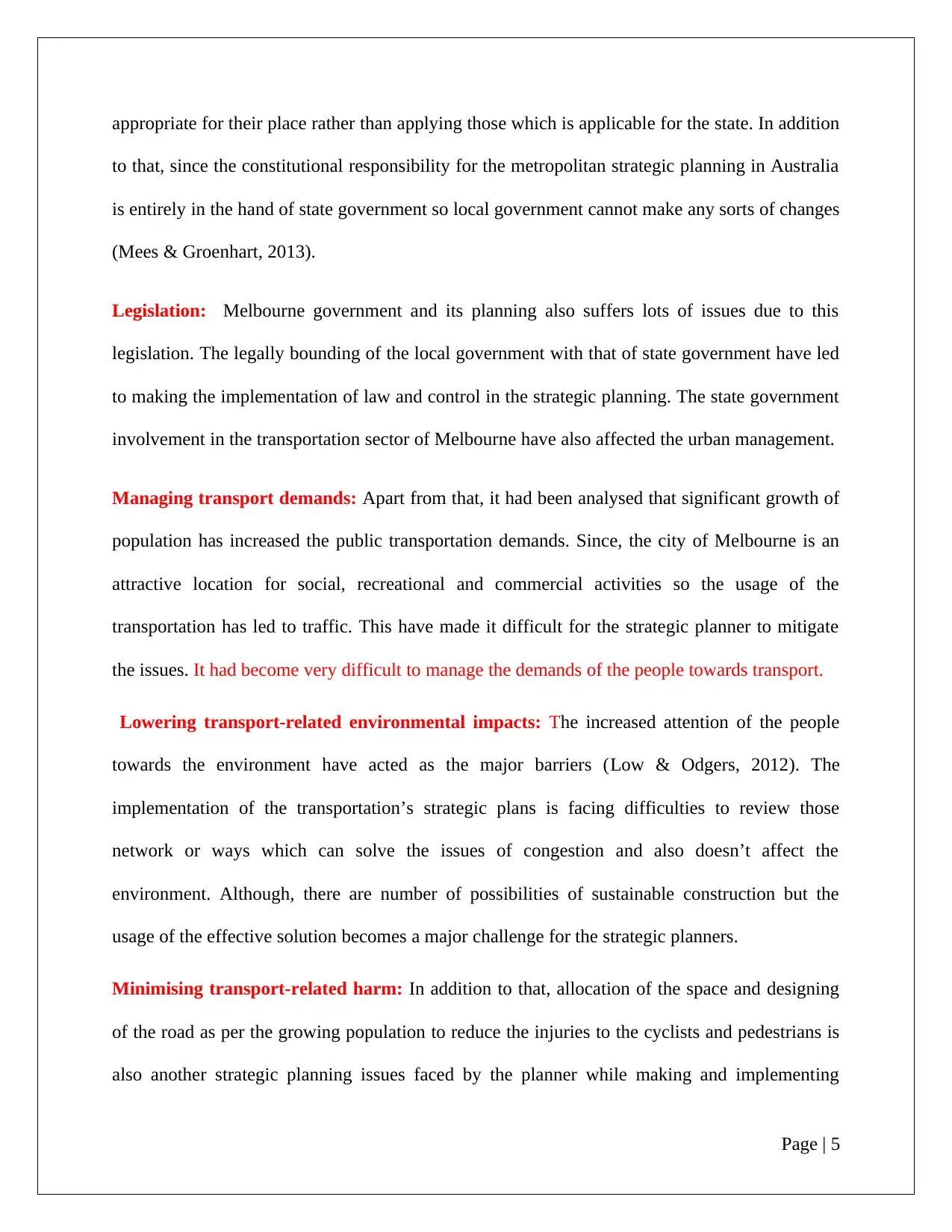
appropriate for their place rather than applying those which is applicable for the state. In addition
to that, since the constitutional responsibility for the metropolitan strategic planning in Australia
is entirely in the hand of state government so local government cannot make any sorts of changes
(Mees & Groenhart, 2013).
Legislation: Melbourne government and its planning also suffers lots of issues due to this
legislation. The legally bounding of the local government with that of state government have led
to making the implementation of law and control in the strategic planning. The state government
involvement in the transportation sector of Melbourne have also affected the urban management.
Managing transport demands: Apart from that, it had been analysed that significant growth of
population has increased the public transportation demands. Since, the city of Melbourne is an
attractive location for social, recreational and commercial activities so the usage of the
transportation has led to traffic. This have made it difficult for the strategic planner to mitigate
the issues. It had become very difficult to manage the demands of the people towards transport.
Lowering transport-related environmental impacts: The increased attention of the people
towards the environment have acted as the major barriers (Low & Odgers, 2012). The
implementation of the transportation’s strategic plans is facing difficulties to review those
network or ways which can solve the issues of congestion and also doesn’t affect the
environment. Although, there are number of possibilities of sustainable construction but the
usage of the effective solution becomes a major challenge for the strategic planners.
Minimising transport-related harm: In addition to that, allocation of the space and designing
of the road as per the growing population to reduce the injuries to the cyclists and pedestrians is
also another strategic planning issues faced by the planner while making and implementing
Page | 5
to that, since the constitutional responsibility for the metropolitan strategic planning in Australia
is entirely in the hand of state government so local government cannot make any sorts of changes
(Mees & Groenhart, 2013).
Legislation: Melbourne government and its planning also suffers lots of issues due to this
legislation. The legally bounding of the local government with that of state government have led
to making the implementation of law and control in the strategic planning. The state government
involvement in the transportation sector of Melbourne have also affected the urban management.
Managing transport demands: Apart from that, it had been analysed that significant growth of
population has increased the public transportation demands. Since, the city of Melbourne is an
attractive location for social, recreational and commercial activities so the usage of the
transportation has led to traffic. This have made it difficult for the strategic planner to mitigate
the issues. It had become very difficult to manage the demands of the people towards transport.
Lowering transport-related environmental impacts: The increased attention of the people
towards the environment have acted as the major barriers (Low & Odgers, 2012). The
implementation of the transportation’s strategic plans is facing difficulties to review those
network or ways which can solve the issues of congestion and also doesn’t affect the
environment. Although, there are number of possibilities of sustainable construction but the
usage of the effective solution becomes a major challenge for the strategic planners.
Minimising transport-related harm: In addition to that, allocation of the space and designing
of the road as per the growing population to reduce the injuries to the cyclists and pedestrians is
also another strategic planning issues faced by the planner while making and implementing
Page | 5
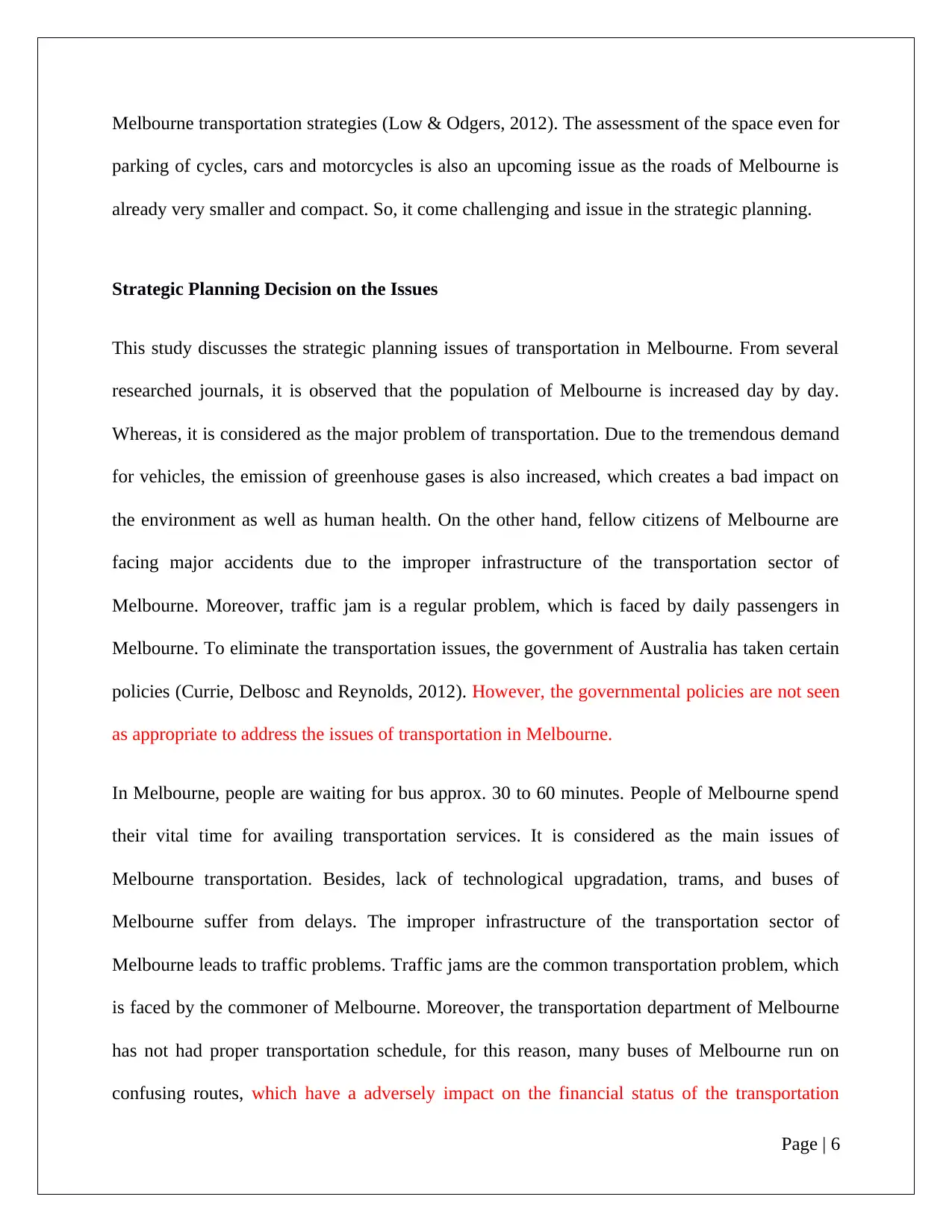
Melbourne transportation strategies (Low & Odgers, 2012). The assessment of the space even for
parking of cycles, cars and motorcycles is also an upcoming issue as the roads of Melbourne is
already very smaller and compact. So, it come challenging and issue in the strategic planning.
Strategic Planning Decision on the Issues
This study discusses the strategic planning issues of transportation in Melbourne. From several
researched journals, it is observed that the population of Melbourne is increased day by day.
Whereas, it is considered as the major problem of transportation. Due to the tremendous demand
for vehicles, the emission of greenhouse gases is also increased, which creates a bad impact on
the environment as well as human health. On the other hand, fellow citizens of Melbourne are
facing major accidents due to the improper infrastructure of the transportation sector of
Melbourne. Moreover, traffic jam is a regular problem, which is faced by daily passengers in
Melbourne. To eliminate the transportation issues, the government of Australia has taken certain
policies (Currie, Delbosc and Reynolds, 2012). However, the governmental policies are not seen
as appropriate to address the issues of transportation in Melbourne.
In Melbourne, people are waiting for bus approx. 30 to 60 minutes. People of Melbourne spend
their vital time for availing transportation services. It is considered as the main issues of
Melbourne transportation. Besides, lack of technological upgradation, trams, and buses of
Melbourne suffer from delays. The improper infrastructure of the transportation sector of
Melbourne leads to traffic problems. Traffic jams are the common transportation problem, which
is faced by the commoner of Melbourne. Moreover, the transportation department of Melbourne
has not had proper transportation schedule, for this reason, many buses of Melbourne run on
confusing routes, which have a adversely impact on the financial status of the transportation
Page | 6
parking of cycles, cars and motorcycles is also an upcoming issue as the roads of Melbourne is
already very smaller and compact. So, it come challenging and issue in the strategic planning.
Strategic Planning Decision on the Issues
This study discusses the strategic planning issues of transportation in Melbourne. From several
researched journals, it is observed that the population of Melbourne is increased day by day.
Whereas, it is considered as the major problem of transportation. Due to the tremendous demand
for vehicles, the emission of greenhouse gases is also increased, which creates a bad impact on
the environment as well as human health. On the other hand, fellow citizens of Melbourne are
facing major accidents due to the improper infrastructure of the transportation sector of
Melbourne. Moreover, traffic jam is a regular problem, which is faced by daily passengers in
Melbourne. To eliminate the transportation issues, the government of Australia has taken certain
policies (Currie, Delbosc and Reynolds, 2012). However, the governmental policies are not seen
as appropriate to address the issues of transportation in Melbourne.
In Melbourne, people are waiting for bus approx. 30 to 60 minutes. People of Melbourne spend
their vital time for availing transportation services. It is considered as the main issues of
Melbourne transportation. Besides, lack of technological upgradation, trams, and buses of
Melbourne suffer from delays. The improper infrastructure of the transportation sector of
Melbourne leads to traffic problems. Traffic jams are the common transportation problem, which
is faced by the commoner of Melbourne. Moreover, the transportation department of Melbourne
has not had proper transportation schedule, for this reason, many buses of Melbourne run on
confusing routes, which have a adversely impact on the financial status of the transportation
Page | 6
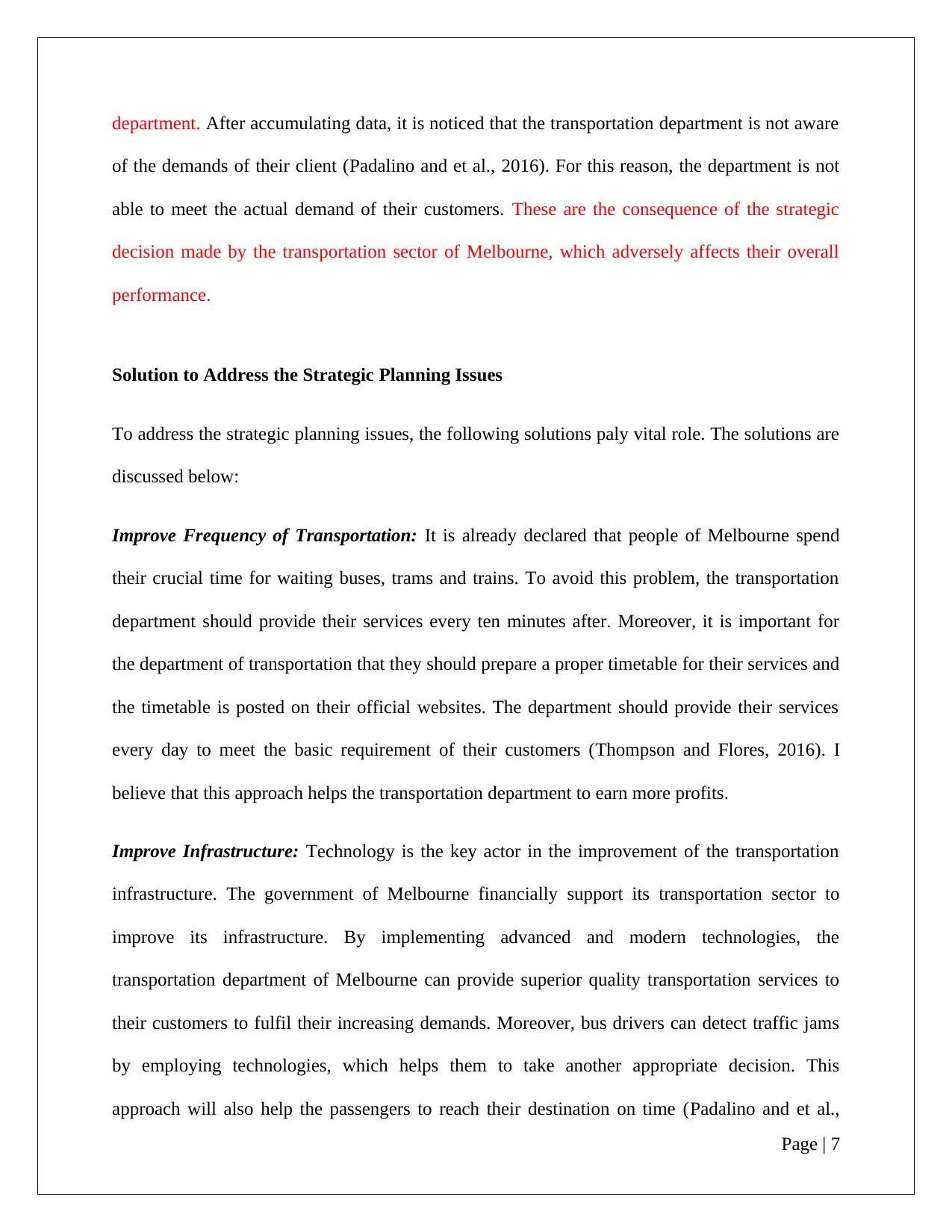
department. After accumulating data, it is noticed that the transportation department is not aware
of the demands of their client (Padalino and et al., 2016). For this reason, the department is not
able to meet the actual demand of their customers. These are the consequence of the strategic
decision made by the transportation sector of Melbourne, which adversely affects their overall
performance.
Solution to Address the Strategic Planning Issues
To address the strategic planning issues, the following solutions paly vital role. The solutions are
discussed below:
Improve Frequency of Transportation: It is already declared that people of Melbourne spend
their crucial time for waiting buses, trams and trains. To avoid this problem, the transportation
department should provide their services every ten minutes after. Moreover, it is important for
the department of transportation that they should prepare a proper timetable for their services and
the timetable is posted on their official websites. The department should provide their services
every day to meet the basic requirement of their customers (Thompson and Flores, 2016). I
believe that this approach helps the transportation department to earn more profits.
Improve Infrastructure: Technology is the key actor in the improvement of the transportation
infrastructure. The government of Melbourne financially support its transportation sector to
improve its infrastructure. By implementing advanced and modern technologies, the
transportation department of Melbourne can provide superior quality transportation services to
their customers to fulfil their increasing demands. Moreover, bus drivers can detect traffic jams
by employing technologies, which helps them to take another appropriate decision. This
approach will also help the passengers to reach their destination on time (Padalino and et al.,
Page | 7
of the demands of their client (Padalino and et al., 2016). For this reason, the department is not
able to meet the actual demand of their customers. These are the consequence of the strategic
decision made by the transportation sector of Melbourne, which adversely affects their overall
performance.
Solution to Address the Strategic Planning Issues
To address the strategic planning issues, the following solutions paly vital role. The solutions are
discussed below:
Improve Frequency of Transportation: It is already declared that people of Melbourne spend
their crucial time for waiting buses, trams and trains. To avoid this problem, the transportation
department should provide their services every ten minutes after. Moreover, it is important for
the department of transportation that they should prepare a proper timetable for their services and
the timetable is posted on their official websites. The department should provide their services
every day to meet the basic requirement of their customers (Thompson and Flores, 2016). I
believe that this approach helps the transportation department to earn more profits.
Improve Infrastructure: Technology is the key actor in the improvement of the transportation
infrastructure. The government of Melbourne financially support its transportation sector to
improve its infrastructure. By implementing advanced and modern technologies, the
transportation department of Melbourne can provide superior quality transportation services to
their customers to fulfil their increasing demands. Moreover, bus drivers can detect traffic jams
by employing technologies, which helps them to take another appropriate decision. This
approach will also help the passengers to reach their destination on time (Padalino and et al.,
Page | 7
Paraphrase This Document
Need a fresh take? Get an instant paraphrase of this document with our AI Paraphraser
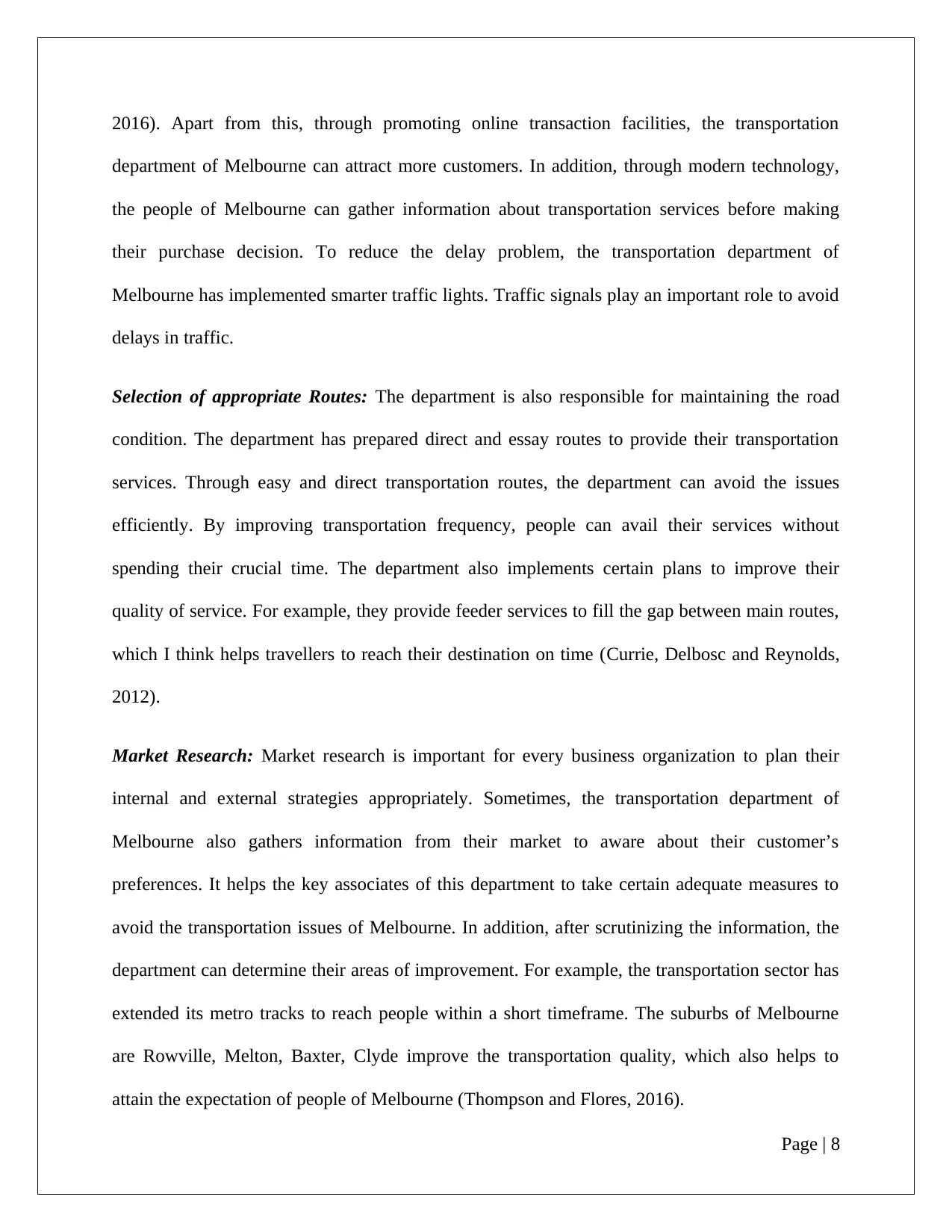
2016). Apart from this, through promoting online transaction facilities, the transportation
department of Melbourne can attract more customers. In addition, through modern technology,
the people of Melbourne can gather information about transportation services before making
their purchase decision. To reduce the delay problem, the transportation department of
Melbourne has implemented smarter traffic lights. Traffic signals play an important role to avoid
delays in traffic.
Selection of appropriate Routes: The department is also responsible for maintaining the road
condition. The department has prepared direct and essay routes to provide their transportation
services. Through easy and direct transportation routes, the department can avoid the issues
efficiently. By improving transportation frequency, people can avail their services without
spending their crucial time. The department also implements certain plans to improve their
quality of service. For example, they provide feeder services to fill the gap between main routes,
which I think helps travellers to reach their destination on time (Currie, Delbosc and Reynolds,
2012).
Market Research: Market research is important for every business organization to plan their
internal and external strategies appropriately. Sometimes, the transportation department of
Melbourne also gathers information from their market to aware about their customer’s
preferences. It helps the key associates of this department to take certain adequate measures to
avoid the transportation issues of Melbourne. In addition, after scrutinizing the information, the
department can determine their areas of improvement. For example, the transportation sector has
extended its metro tracks to reach people within a short timeframe. The suburbs of Melbourne
are Rowville, Melton, Baxter, Clyde improve the transportation quality, which also helps to
attain the expectation of people of Melbourne (Thompson and Flores, 2016).
Page | 8
department of Melbourne can attract more customers. In addition, through modern technology,
the people of Melbourne can gather information about transportation services before making
their purchase decision. To reduce the delay problem, the transportation department of
Melbourne has implemented smarter traffic lights. Traffic signals play an important role to avoid
delays in traffic.
Selection of appropriate Routes: The department is also responsible for maintaining the road
condition. The department has prepared direct and essay routes to provide their transportation
services. Through easy and direct transportation routes, the department can avoid the issues
efficiently. By improving transportation frequency, people can avail their services without
spending their crucial time. The department also implements certain plans to improve their
quality of service. For example, they provide feeder services to fill the gap between main routes,
which I think helps travellers to reach their destination on time (Currie, Delbosc and Reynolds,
2012).
Market Research: Market research is important for every business organization to plan their
internal and external strategies appropriately. Sometimes, the transportation department of
Melbourne also gathers information from their market to aware about their customer’s
preferences. It helps the key associates of this department to take certain adequate measures to
avoid the transportation issues of Melbourne. In addition, after scrutinizing the information, the
department can determine their areas of improvement. For example, the transportation sector has
extended its metro tracks to reach people within a short timeframe. The suburbs of Melbourne
are Rowville, Melton, Baxter, Clyde improve the transportation quality, which also helps to
attain the expectation of people of Melbourne (Thompson and Flores, 2016).
Page | 8
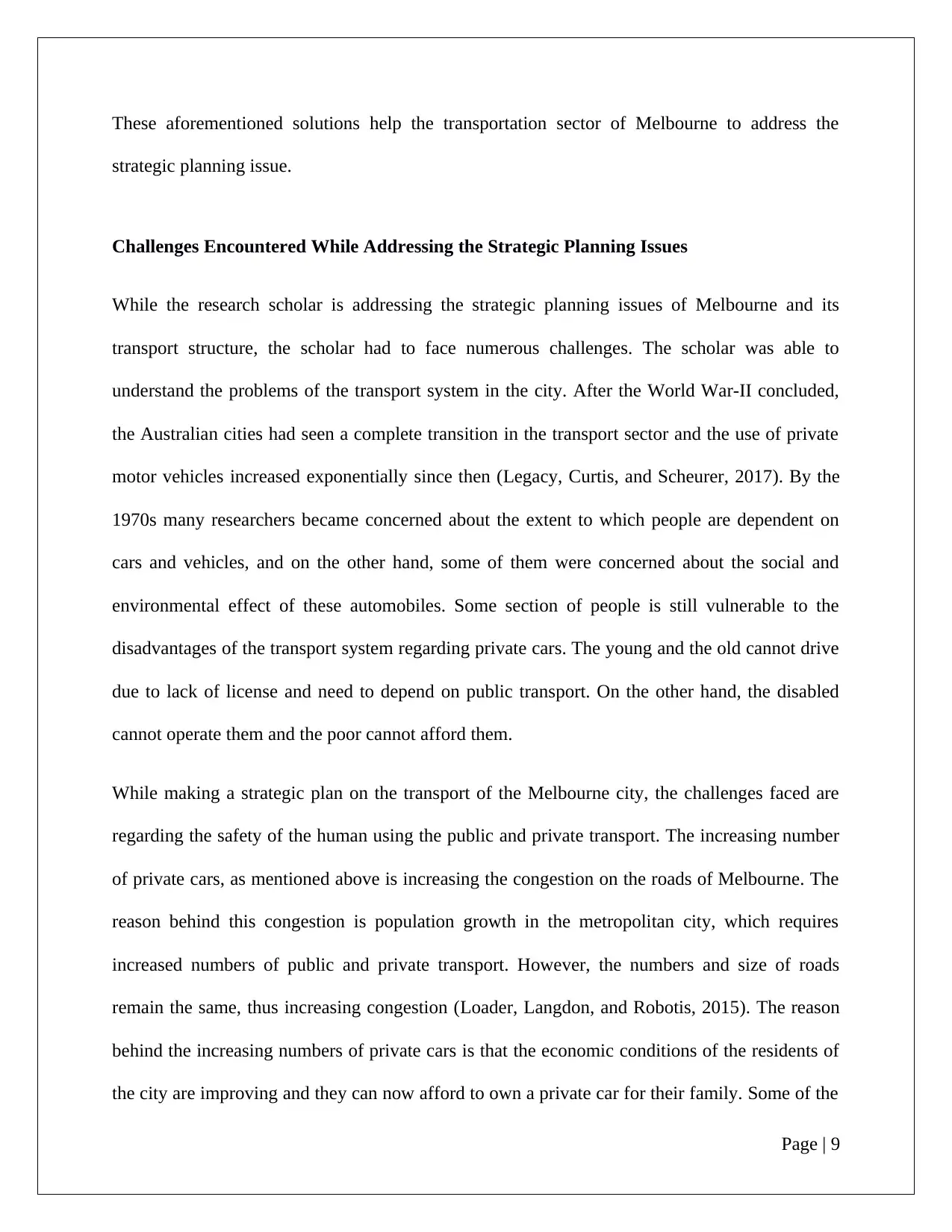
These aforementioned solutions help the transportation sector of Melbourne to address the
strategic planning issue.
Challenges Encountered While Addressing the Strategic Planning Issues
While the research scholar is addressing the strategic planning issues of Melbourne and its
transport structure, the scholar had to face numerous challenges. The scholar was able to
understand the problems of the transport system in the city. After the World War-II concluded,
the Australian cities had seen a complete transition in the transport sector and the use of private
motor vehicles increased exponentially since then (Legacy, Curtis, and Scheurer, 2017). By the
1970s many researchers became concerned about the extent to which people are dependent on
cars and vehicles, and on the other hand, some of them were concerned about the social and
environmental effect of these automobiles. Some section of people is still vulnerable to the
disadvantages of the transport system regarding private cars. The young and the old cannot drive
due to lack of license and need to depend on public transport. On the other hand, the disabled
cannot operate them and the poor cannot afford them.
While making a strategic plan on the transport of the Melbourne city, the challenges faced are
regarding the safety of the human using the public and private transport. The increasing number
of private cars, as mentioned above is increasing the congestion on the roads of Melbourne. The
reason behind this congestion is population growth in the metropolitan city, which requires
increased numbers of public and private transport. However, the numbers and size of roads
remain the same, thus increasing congestion (Loader, Langdon, and Robotis, 2015). The reason
behind the increasing numbers of private cars is that the economic conditions of the residents of
the city are improving and they can now afford to own a private car for their family. Some of the
Page | 9
strategic planning issue.
Challenges Encountered While Addressing the Strategic Planning Issues
While the research scholar is addressing the strategic planning issues of Melbourne and its
transport structure, the scholar had to face numerous challenges. The scholar was able to
understand the problems of the transport system in the city. After the World War-II concluded,
the Australian cities had seen a complete transition in the transport sector and the use of private
motor vehicles increased exponentially since then (Legacy, Curtis, and Scheurer, 2017). By the
1970s many researchers became concerned about the extent to which people are dependent on
cars and vehicles, and on the other hand, some of them were concerned about the social and
environmental effect of these automobiles. Some section of people is still vulnerable to the
disadvantages of the transport system regarding private cars. The young and the old cannot drive
due to lack of license and need to depend on public transport. On the other hand, the disabled
cannot operate them and the poor cannot afford them.
While making a strategic plan on the transport of the Melbourne city, the challenges faced are
regarding the safety of the human using the public and private transport. The increasing number
of private cars, as mentioned above is increasing the congestion on the roads of Melbourne. The
reason behind this congestion is population growth in the metropolitan city, which requires
increased numbers of public and private transport. However, the numbers and size of roads
remain the same, thus increasing congestion (Loader, Langdon, and Robotis, 2015). The reason
behind the increasing numbers of private cars is that the economic conditions of the residents of
the city are improving and they can now afford to own a private car for their family. Some of the
Page | 9

families can even have multiple cars. The people who still use public transport are in the lower
income group, and their employment status is low too.
Recommendation to Address the Strategic Planning Issues
To improve the transport facilities in the Melbourne city of Australia, the government and
private sector must come together and take certain steps. The transport system of Australia
already has some assets, which are the public transport network, not just the public transport
vehicles, and the arterial roads. Around the suburban areas, they can increase the number of
roads and make alternate routes which the public transport vehicles can use when the most used
roads are congested (Goodman, 2017). However, to reduce the congestion in the road, they can
use the railway system and make new railway tracks, which can be used for public transport.
However, to make it a reality, the cost of the rides of those trains must be made cheaper or equal
to buses. Moreover, the people who use private cars and other private vehicles should be given
‘Park and Ride’ facility, mostly along the congested corridors. The freight vehicles should be
moved faster and if possible new and separate roads should be made for those, which will reduce
congestion.
The main reason behind this congestion is that Melbourne itself supply those materials in freight
vehicles to other small cities and towns and its roads are therefore used for that particular work.
For small distance travel by people going to work and for the students who do not live far away
from their schools and colleges can look for a greener option, which are non-motorized vehicles
like a bicycle. They can even choose to walk the distance, which will definitely help in reducing
congestion in the city roads. However, to make it possible the government must prioritize them
and make ways which the pedestrian and cyclist can use in the near future (Legacy, 2016). The
Page | 10
income group, and their employment status is low too.
Recommendation to Address the Strategic Planning Issues
To improve the transport facilities in the Melbourne city of Australia, the government and
private sector must come together and take certain steps. The transport system of Australia
already has some assets, which are the public transport network, not just the public transport
vehicles, and the arterial roads. Around the suburban areas, they can increase the number of
roads and make alternate routes which the public transport vehicles can use when the most used
roads are congested (Goodman, 2017). However, to reduce the congestion in the road, they can
use the railway system and make new railway tracks, which can be used for public transport.
However, to make it a reality, the cost of the rides of those trains must be made cheaper or equal
to buses. Moreover, the people who use private cars and other private vehicles should be given
‘Park and Ride’ facility, mostly along the congested corridors. The freight vehicles should be
moved faster and if possible new and separate roads should be made for those, which will reduce
congestion.
The main reason behind this congestion is that Melbourne itself supply those materials in freight
vehicles to other small cities and towns and its roads are therefore used for that particular work.
For small distance travel by people going to work and for the students who do not live far away
from their schools and colleges can look for a greener option, which are non-motorized vehicles
like a bicycle. They can even choose to walk the distance, which will definitely help in reducing
congestion in the city roads. However, to make it possible the government must prioritize them
and make ways which the pedestrian and cyclist can use in the near future (Legacy, 2016). The
Page | 10
Secure Best Marks with AI Grader
Need help grading? Try our AI Grader for instant feedback on your assignments.
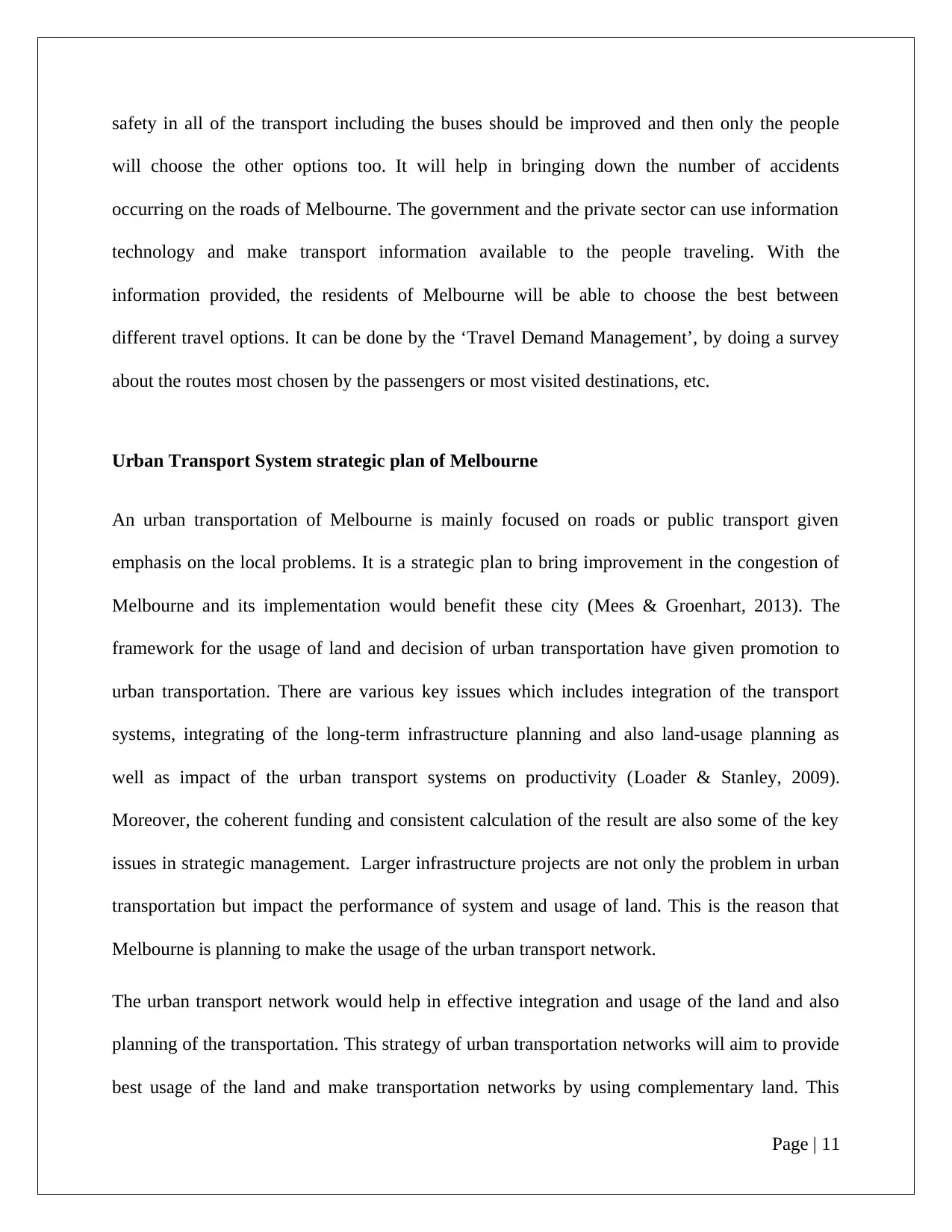
safety in all of the transport including the buses should be improved and then only the people
will choose the other options too. It will help in bringing down the number of accidents
occurring on the roads of Melbourne. The government and the private sector can use information
technology and make transport information available to the people traveling. With the
information provided, the residents of Melbourne will be able to choose the best between
different travel options. It can be done by the ‘Travel Demand Management’, by doing a survey
about the routes most chosen by the passengers or most visited destinations, etc.
Urban Transport System strategic plan of Melbourne
An urban transportation of Melbourne is mainly focused on roads or public transport given
emphasis on the local problems. It is a strategic plan to bring improvement in the congestion of
Melbourne and its implementation would benefit these city (Mees & Groenhart, 2013). The
framework for the usage of land and decision of urban transportation have given promotion to
urban transportation. There are various key issues which includes integration of the transport
systems, integrating of the long-term infrastructure planning and also land-usage planning as
well as impact of the urban transport systems on productivity (Loader & Stanley, 2009).
Moreover, the coherent funding and consistent calculation of the result are also some of the key
issues in strategic management. Larger infrastructure projects are not only the problem in urban
transportation but impact the performance of system and usage of land. This is the reason that
Melbourne is planning to make the usage of the urban transport network.
The urban transport network would help in effective integration and usage of the land and also
planning of the transportation. This strategy of urban transportation networks will aim to provide
best usage of the land and make transportation networks by using complementary land. This
Page | 11
will choose the other options too. It will help in bringing down the number of accidents
occurring on the roads of Melbourne. The government and the private sector can use information
technology and make transport information available to the people traveling. With the
information provided, the residents of Melbourne will be able to choose the best between
different travel options. It can be done by the ‘Travel Demand Management’, by doing a survey
about the routes most chosen by the passengers or most visited destinations, etc.
Urban Transport System strategic plan of Melbourne
An urban transportation of Melbourne is mainly focused on roads or public transport given
emphasis on the local problems. It is a strategic plan to bring improvement in the congestion of
Melbourne and its implementation would benefit these city (Mees & Groenhart, 2013). The
framework for the usage of land and decision of urban transportation have given promotion to
urban transportation. There are various key issues which includes integration of the transport
systems, integrating of the long-term infrastructure planning and also land-usage planning as
well as impact of the urban transport systems on productivity (Loader & Stanley, 2009).
Moreover, the coherent funding and consistent calculation of the result are also some of the key
issues in strategic management. Larger infrastructure projects are not only the problem in urban
transportation but impact the performance of system and usage of land. This is the reason that
Melbourne is planning to make the usage of the urban transport network.
The urban transport network would help in effective integration and usage of the land and also
planning of the transportation. This strategy of urban transportation networks will aim to provide
best usage of the land and make transportation networks by using complementary land. This
Page | 11
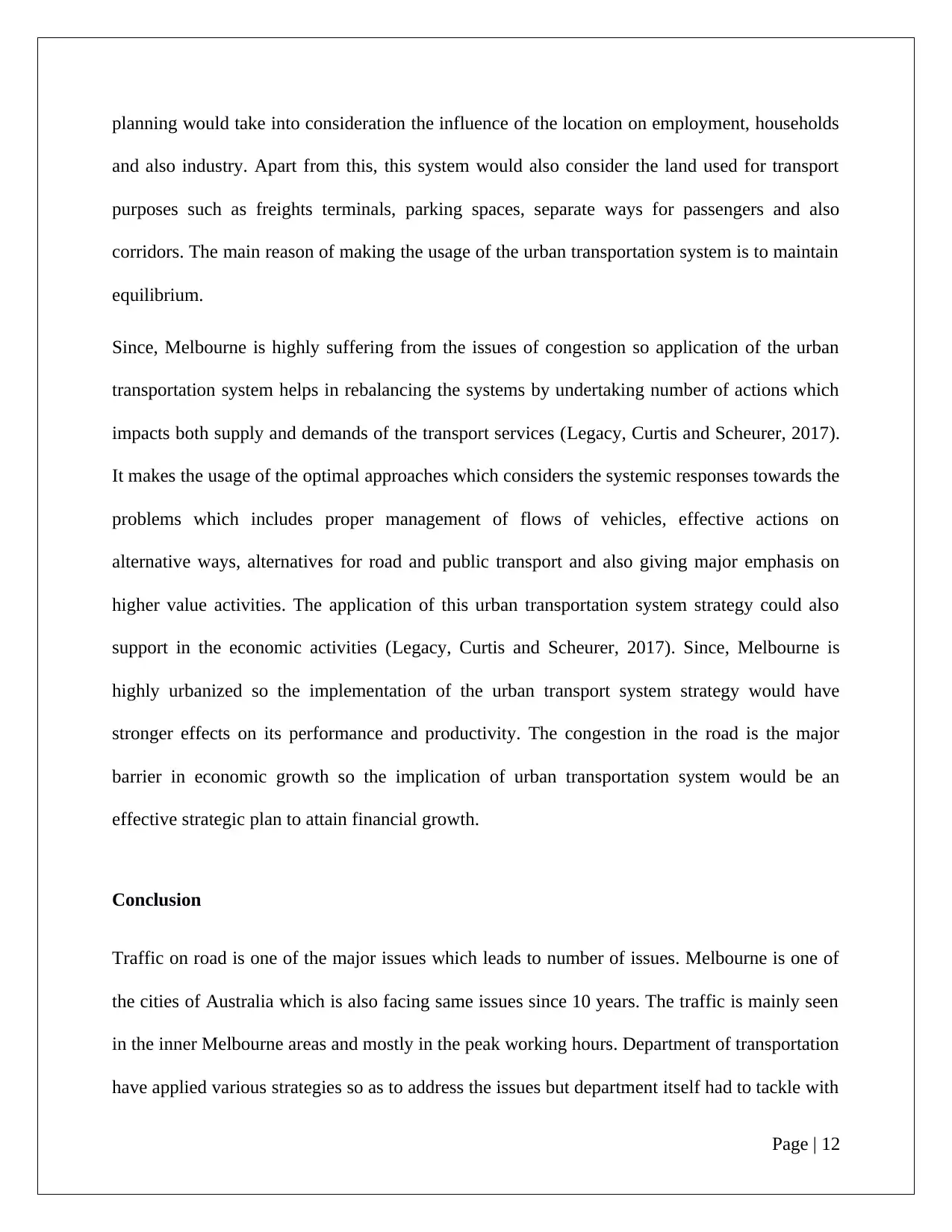
planning would take into consideration the influence of the location on employment, households
and also industry. Apart from this, this system would also consider the land used for transport
purposes such as freights terminals, parking spaces, separate ways for passengers and also
corridors. The main reason of making the usage of the urban transportation system is to maintain
equilibrium.
Since, Melbourne is highly suffering from the issues of congestion so application of the urban
transportation system helps in rebalancing the systems by undertaking number of actions which
impacts both supply and demands of the transport services (Legacy, Curtis and Scheurer, 2017).
It makes the usage of the optimal approaches which considers the systemic responses towards the
problems which includes proper management of flows of vehicles, effective actions on
alternative ways, alternatives for road and public transport and also giving major emphasis on
higher value activities. The application of this urban transportation system strategy could also
support in the economic activities (Legacy, Curtis and Scheurer, 2017). Since, Melbourne is
highly urbanized so the implementation of the urban transport system strategy would have
stronger effects on its performance and productivity. The congestion in the road is the major
barrier in economic growth so the implication of urban transportation system would be an
effective strategic plan to attain financial growth.
Conclusion
Traffic on road is one of the major issues which leads to number of issues. Melbourne is one of
the cities of Australia which is also facing same issues since 10 years. The traffic is mainly seen
in the inner Melbourne areas and mostly in the peak working hours. Department of transportation
have applied various strategies so as to address the issues but department itself had to tackle with
Page | 12
and also industry. Apart from this, this system would also consider the land used for transport
purposes such as freights terminals, parking spaces, separate ways for passengers and also
corridors. The main reason of making the usage of the urban transportation system is to maintain
equilibrium.
Since, Melbourne is highly suffering from the issues of congestion so application of the urban
transportation system helps in rebalancing the systems by undertaking number of actions which
impacts both supply and demands of the transport services (Legacy, Curtis and Scheurer, 2017).
It makes the usage of the optimal approaches which considers the systemic responses towards the
problems which includes proper management of flows of vehicles, effective actions on
alternative ways, alternatives for road and public transport and also giving major emphasis on
higher value activities. The application of this urban transportation system strategy could also
support in the economic activities (Legacy, Curtis and Scheurer, 2017). Since, Melbourne is
highly urbanized so the implementation of the urban transport system strategy would have
stronger effects on its performance and productivity. The congestion in the road is the major
barrier in economic growth so the implication of urban transportation system would be an
effective strategic plan to attain financial growth.
Conclusion
Traffic on road is one of the major issues which leads to number of issues. Melbourne is one of
the cities of Australia which is also facing same issues since 10 years. The traffic is mainly seen
in the inner Melbourne areas and mostly in the peak working hours. Department of transportation
have applied various strategies so as to address the issues but department itself had to tackle with
Page | 12
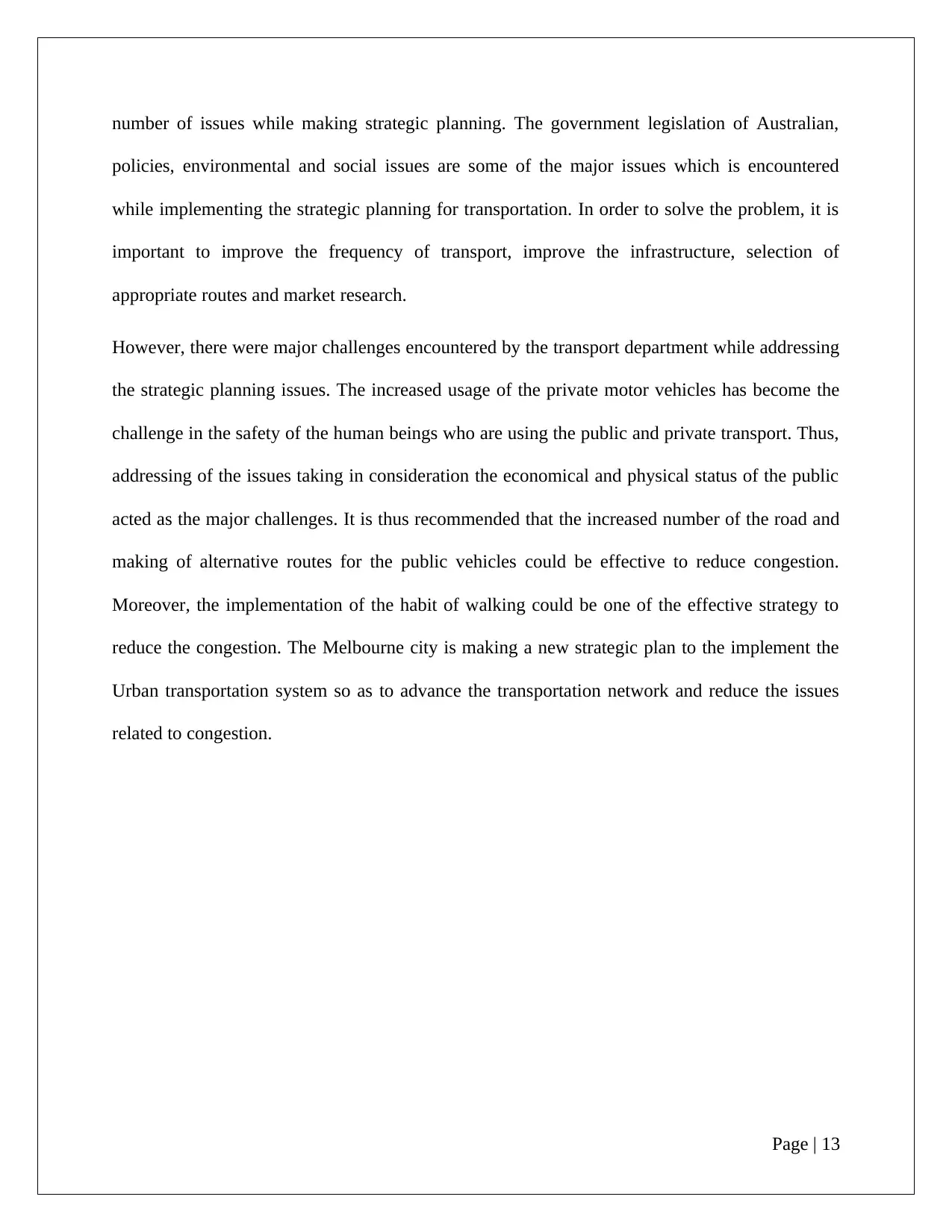
number of issues while making strategic planning. The government legislation of Australian,
policies, environmental and social issues are some of the major issues which is encountered
while implementing the strategic planning for transportation. In order to solve the problem, it is
important to improve the frequency of transport, improve the infrastructure, selection of
appropriate routes and market research.
However, there were major challenges encountered by the transport department while addressing
the strategic planning issues. The increased usage of the private motor vehicles has become the
challenge in the safety of the human beings who are using the public and private transport. Thus,
addressing of the issues taking in consideration the economical and physical status of the public
acted as the major challenges. It is thus recommended that the increased number of the road and
making of alternative routes for the public vehicles could be effective to reduce congestion.
Moreover, the implementation of the habit of walking could be one of the effective strategy to
reduce the congestion. The Melbourne city is making a new strategic plan to the implement the
Urban transportation system so as to advance the transportation network and reduce the issues
related to congestion.
Page | 13
policies, environmental and social issues are some of the major issues which is encountered
while implementing the strategic planning for transportation. In order to solve the problem, it is
important to improve the frequency of transport, improve the infrastructure, selection of
appropriate routes and market research.
However, there were major challenges encountered by the transport department while addressing
the strategic planning issues. The increased usage of the private motor vehicles has become the
challenge in the safety of the human beings who are using the public and private transport. Thus,
addressing of the issues taking in consideration the economical and physical status of the public
acted as the major challenges. It is thus recommended that the increased number of the road and
making of alternative routes for the public vehicles could be effective to reduce congestion.
Moreover, the implementation of the habit of walking could be one of the effective strategy to
reduce the congestion. The Melbourne city is making a new strategic plan to the implement the
Urban transportation system so as to advance the transportation network and reduce the issues
related to congestion.
Page | 13
Paraphrase This Document
Need a fresh take? Get an instant paraphrase of this document with our AI Paraphraser

References
Currie, G., Delbosc, A. and Reynolds, J., 2012. Modeling dwell time for streetcars in Melbourne,
Australia, and Toronto, Canada. Transportation Research Record, 2275(1), pp.22-29.
Freestone, R. (2010). Urban Nation: Australia's Planning Heritage. Collingwood, Victoria:
CSIRO
Publishing.
Freestone, R., 2010. Urban Nation: Australia's Planning Heritage. Collingwood, Victoria:
CSIRO Publishing.
Goodman, R., 2017. Melbourne: Growing Pains for the Liveable City. In Planning Metropolitan
Australia (pp. 59-83). Routledge.
Infrastructure Australia, 2012. Infrastructure Finance and Funding Reform. April 2012. The
Infrastructure Finance Working Group (IFWG), Canberra: Australian Government.
Legacy, C., 2016. Transforming transport planning in the post political era. Urban
studies, 53(14), pp.3108-3124.
Loader, C., & Stanley, J., 2009. Growing bus patronage and addressing transport disadvantage—
The Melbourne experience. Transport Policy, Vol. No. 16, No. 3, pp. 106-114.
Low, N., & Odgers, J. (2012). Rethinking the Cost of Traffic Congestion, Lessons from
Melbourne's
City Link Toll Roads. Urban Policy and Research, 30(2), 189-205.
Page | 14
Currie, G., Delbosc, A. and Reynolds, J., 2012. Modeling dwell time for streetcars in Melbourne,
Australia, and Toronto, Canada. Transportation Research Record, 2275(1), pp.22-29.
Freestone, R. (2010). Urban Nation: Australia's Planning Heritage. Collingwood, Victoria:
CSIRO
Publishing.
Freestone, R., 2010. Urban Nation: Australia's Planning Heritage. Collingwood, Victoria:
CSIRO Publishing.
Goodman, R., 2017. Melbourne: Growing Pains for the Liveable City. In Planning Metropolitan
Australia (pp. 59-83). Routledge.
Infrastructure Australia, 2012. Infrastructure Finance and Funding Reform. April 2012. The
Infrastructure Finance Working Group (IFWG), Canberra: Australian Government.
Legacy, C., 2016. Transforming transport planning in the post political era. Urban
studies, 53(14), pp.3108-3124.
Loader, C., & Stanley, J., 2009. Growing bus patronage and addressing transport disadvantage—
The Melbourne experience. Transport Policy, Vol. No. 16, No. 3, pp. 106-114.
Low, N., & Odgers, J. (2012). Rethinking the Cost of Traffic Congestion, Lessons from
Melbourne's
City Link Toll Roads. Urban Policy and Research, 30(2), 189-205.
Page | 14
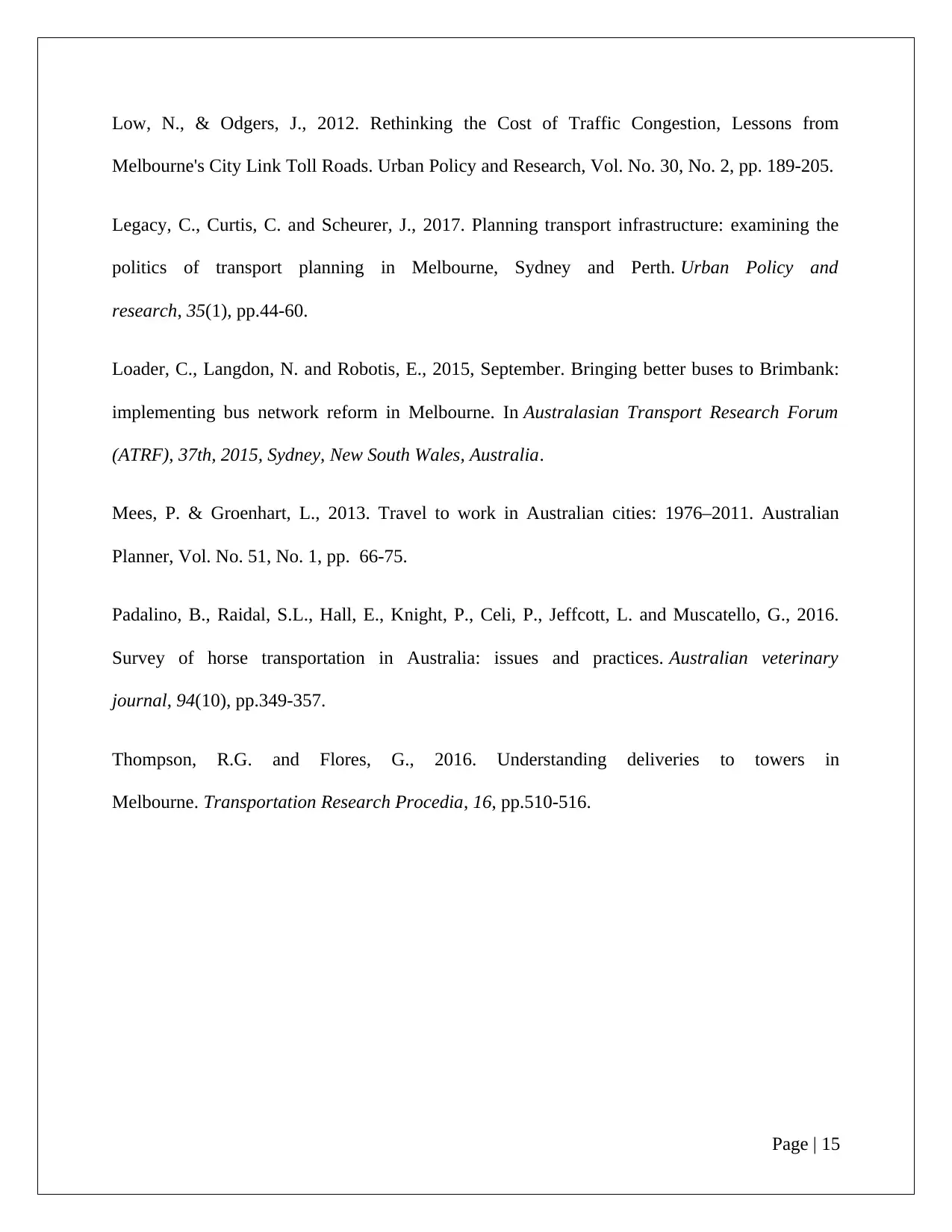
Low, N., & Odgers, J., 2012. Rethinking the Cost of Traffic Congestion, Lessons from
Melbourne's City Link Toll Roads. Urban Policy and Research, Vol. No. 30, No. 2, pp. 189-205.
Legacy, C., Curtis, C. and Scheurer, J., 2017. Planning transport infrastructure: examining the
politics of transport planning in Melbourne, Sydney and Perth. Urban Policy and
research, 35(1), pp.44-60.
Loader, C., Langdon, N. and Robotis, E., 2015, September. Bringing better buses to Brimbank:
implementing bus network reform in Melbourne. In Australasian Transport Research Forum
(ATRF), 37th, 2015, Sydney, New South Wales, Australia.
Mees, P. & Groenhart, L., 2013. Travel to work in Australian cities: 1976–2011. Australian
Planner, Vol. No. 51, No. 1, pp. 66-75.
Padalino, B., Raidal, S.L., Hall, E., Knight, P., Celi, P., Jeffcott, L. and Muscatello, G., 2016.
Survey of horse transportation in Australia: issues and practices. Australian veterinary
journal, 94(10), pp.349-357.
Thompson, R.G. and Flores, G., 2016. Understanding deliveries to towers in
Melbourne. Transportation Research Procedia, 16, pp.510-516.
Page | 15
Melbourne's City Link Toll Roads. Urban Policy and Research, Vol. No. 30, No. 2, pp. 189-205.
Legacy, C., Curtis, C. and Scheurer, J., 2017. Planning transport infrastructure: examining the
politics of transport planning in Melbourne, Sydney and Perth. Urban Policy and
research, 35(1), pp.44-60.
Loader, C., Langdon, N. and Robotis, E., 2015, September. Bringing better buses to Brimbank:
implementing bus network reform in Melbourne. In Australasian Transport Research Forum
(ATRF), 37th, 2015, Sydney, New South Wales, Australia.
Mees, P. & Groenhart, L., 2013. Travel to work in Australian cities: 1976–2011. Australian
Planner, Vol. No. 51, No. 1, pp. 66-75.
Padalino, B., Raidal, S.L., Hall, E., Knight, P., Celi, P., Jeffcott, L. and Muscatello, G., 2016.
Survey of horse transportation in Australia: issues and practices. Australian veterinary
journal, 94(10), pp.349-357.
Thompson, R.G. and Flores, G., 2016. Understanding deliveries to towers in
Melbourne. Transportation Research Procedia, 16, pp.510-516.
Page | 15
1 out of 15
Related Documents
Your All-in-One AI-Powered Toolkit for Academic Success.
+13062052269
info@desklib.com
Available 24*7 on WhatsApp / Email
![[object Object]](/_next/static/media/star-bottom.7253800d.svg)
Unlock your academic potential
© 2024 | Zucol Services PVT LTD | All rights reserved.





